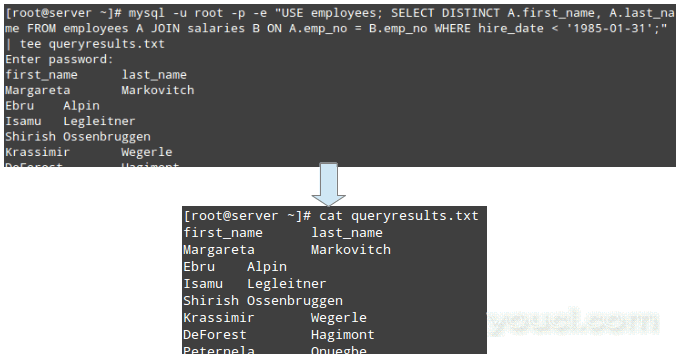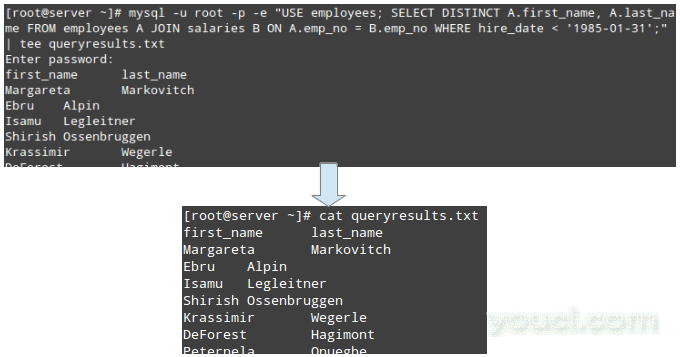如果您负责管理数据库服务器,则有时可能需要运行查询并仔细检查。 虽然你可以做到这一点从MySQL / MariaDB的外壳,但这个技巧可以让你执行的MySQL / MariaDB的查询直接使用Linux命令行和保存输出,为以后的检查文件(这是特别有用的,如果该查询返回大量记录)。
让我们看一些直接从命令行运行查询的简单示例,然后再移至更高级的查询。
要查看服务器上的所有数据库,您可以发出以下命令:
# mysql -u root -p -e "show databases;"
接下来,创建一个名为数据库表tutorials数据库youcldb ,运行下面的命令:
$ mysql -u root -p -e "USE youcldb; CREATE TABLE tutorials(tut_id INT NOT NULL AUTO_INCREMENT, tut_title VARCHAR(100) NOT NULL, tut_author VARCHAR(40) NOT NULL, submissoin_date DATE, PRIMARY KEY (tut_id));"
我们将使用下面的命令和管道输出到tee命令后面我们想要存储输出的文件名。
推荐阅读: 20的MySQL / MariaDB的命令在Linux的数据库管理
为了便于说明,我们将使用一个数据库命名employees与员工和薪金表之间的简单连接。 在你自己的情况下,只需要输入引号之间的SQL查询,然后按Enter。
请注意,系统将提示您输入数据库用户的密码:
# mysql -u root -p -e "USE employees; SELECT DISTINCT A.first_name, A.last_name FROM employees A JOIN salaries B ON A.emp_no = B.emp_no WHERE hire_dateView the query results with the help of cat command.
# cat queryresults.txt
Run MySQL/MariaDB Queries from Commandline
With the query results in a plain text files, you can process the records more easily using other command-line utilities.
Summary
We have shared that you, as a system administrator, may find useful when it comes to automating your daily Linux tasks or performing them more easily.
Suggested Read: How to Backup and Restore MySQL/MariaDB Databases
Do you have any other tips that you would like to share with the rest of the community? If so, please do so using the comment form below.
Otherwise, feel free to let us your thoughts about the assortment of tips that we have looked at, or what we can add or possibly do to improve each of them. We look forward to hearing from you!
查看的帮助下查询结果cat命令 。
# cat queryresults.txt

从命令行运行MySQL / MariaDB查询
使用查询结果的纯文本文件,您可以使用其他命令行实用程序更容易地处理记录。
概要
我们有共同的 ,你作为一个系统管理员,可当谈到找到有用的自动化日常任务的Linux或更轻松地执行它们。
推荐阅读: 如何备份和恢复的MySQL / MariaDB的数据库
您有任何其他提示,您想与社区的其他人分享吗? 如果是,请使用下面的注释表单。
否则,随时让我们对您的想法,我们已经看过的提示,或我们可以添加或可能做的,以改善每个人的想法。 我们期待您的回音!








